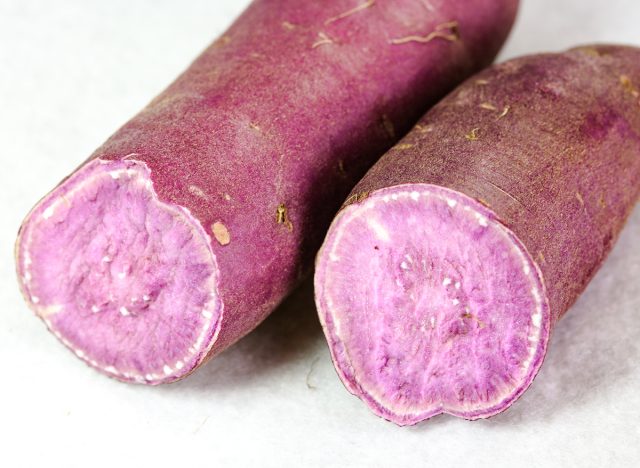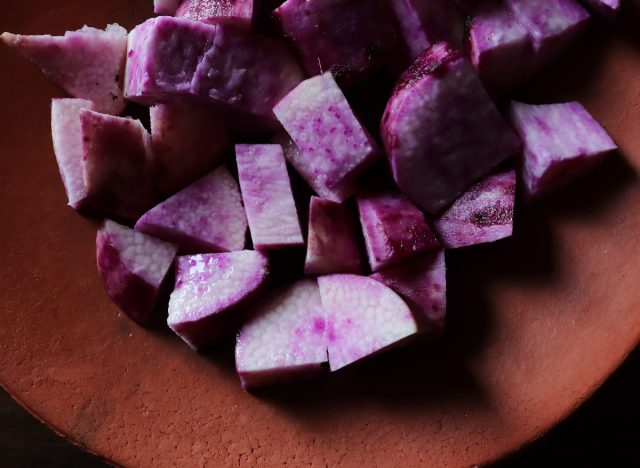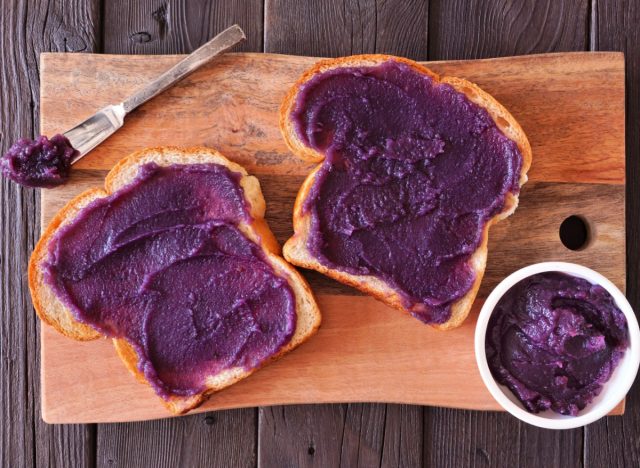The purple yam continues to capture people's attention, but it's more than just a food trend.
Among the many eye-catching foods flooding social media feeds is one versatile, vibrant vegetable, which is transformed in various ways. Perhaps you've come across bright purple donuts, ice cream, and hamburger buns while scrolling through Instagram. Maybe you've encountered a box of violet-hued pancake mix while shopping at Trader Joe's. Despite being different in form, all of these foods can attribute their striking color to the same key element: ube (pronounced "oo-bay").
While commonly associated with its distinctive purple shade, there's more to ube than meets the eye. Here's what you need to know about this aesthetically pleasing ingredient.
 |
| Getty Images |
What Is Ube?
Translating to "tuber" in Tagalog (one of the languages spoken in the Philippines), ube is a purple yam native to Southeast Asia, commonly used in Filipino cuisine. While similar to purple sweet potatoes, ube has a darker, bark-like skin and grows on a vine. Purple sweet potatoes, on the other hand, grow underground and have a smoother skin that can be purple or white, depending on the variety.
Often seen in desserts, ube has been reported to have a mildly sweet, nutty, vanilla flavor. Amy Goodson, MS, RD, CSSD, LD, registered dietitian and author of The Sports Nutrition Playbook, adds that the vegetable has a "coconut-like aroma."
Although ube has been used for centuries, according to a report from Forbes, the root vegetable rose to fame in the United States after Manila Social Club, a former Brooklyn, NY-based Filipino restaurant, released its $100 Golden Cristal Ube Donut in 2015.
 |
| Veena Nair / Getty Images |
What Are The Health Benefits Of This Root Vegetable?
"Like other yam varieties, [ube] is a great source of carbs, fiber, and many micronutrients, including calcium, vitamin C, and iron," says Lauren Manaker, MS, RDN, registered dietitian and author of The First Time Mom's Pregnancy Cookbook and Fueling Male Fertility.
According to the U.S. Department of Agriculture (USDA), 100 grams (3.5 ounces) of ube contains:
- 120 calories
- 1 gram of protein
- 0 grams of fat
- 27 grams of carbs
- 4 grams of fiber
- 0 grams of sugar
- 20 milligrams of calcium (2% DV)
- 0.36 milligrams of iron (2% DV)
- 12 milligrams of vitamin C (13% DV)
- 100 IU of vitamin A (11% DV)
Within its nutritional composition, ube also contains anthocyanins, which are antioxidants known for giving fruits and vegetables their signature red, blue, and purple colors. These water-soluble pigments have been shown to protect cells from damage caused by free radicals. They've also been tied to reduced inflammation and protection against disease.
Additionally, "ube is both blood sugar-friendly and gut-healthy," Goodson notes. The dietitian highlights the vegetable's low glycemic index, explaining that this "means that the carbs are broken down into sugars slowly, which helps you maintain energy levels instead of a quick spike." In terms of gut health, ube offers resistant starch, a type of starch that has been found to play a role in supplying the gut with healthy bacteria.
Why Is It So Popular?
Although much of the attention directed toward ube can be connected to its attention-grabbing color, Manaker says the purple yam's appeal goes beyond appearance.
"While this root veggie has been popular for years in certain areas of the world, it is only gaining popularity here in the U.S. among groups of people who have never been exposed to it before," she says. "People are being encouraged to explore new foods that are part of other cultures, and because of this, ube may be appealing to try."
How To Eat Ube
 |
| Shutterstock |
Another upside to ube is its incredible versatility.
Classic Filipino recipes starring this ingredient include ube halaya, a sweet jam made with boiled and mashed ube, and halo-halo, which consists of shaved ice, evaporated milk, and toppings like ube, coconut strips, and tapioca.
If you're looking for something sweet, Goodson recommends making a three-ingredient, no-churn ube ice cream with sweetened condensed milk and heavy whipping cream. For a savory option, she suggests ube hummus, which uses the root vegetable instead of the usual chickpeas found in the popular dip.
"Cooking ube is no different than boiling a sweet potato," says Goodson. Just like a yam or potato, the purple tuber can be baked, fried, mashed, and so on. "You can also purchase ube extract and ube powders to throw into a recipe," she adds.
Sources Referenced In This Article:
- Source: https://plants.ifas.ufl.edu/plant-directory/dioscorea-alata/
- Source: https://www.ncbi.nlm.nih.gov/pmc/articles/PMC5613902/#:~:text=Introduction,anthocyanin%20exists%20in%20alkaline%20conditions.
- Source: https://www.ncbi.nlm.nih.gov/pmc/articles/PMC7504512/
- Source: https://www.researchgate.net/publication/281675400_Estimation_of_Nutritional_and_Starch_Characteristics_of_Dioscorea_alata_Water_Yam_Varieties_Commonly_Cultivated_in_the_South-Eastern_Nigeria
- Source: https://pubmed.ncbi.nlm.nih.gov/29620784/
Important Notice: This article was originally published at www.eatthis.com by Brianna Ruback where all credits are due. Fact checked by Jordan Powers Willard
Disclaimer
The watching, interacting, and participation of any kind with anything on this page does not constitute or initiate a doctor-patient relationship with Veripeudic.com. None of the statements here have been evaluated by the Food and Drug Administration (FDA). The products of Veripeudic.com are not intended to diagnose, treat, cure, or prevent any disease. The information being provided should only be considered for education and entertainment purposes only. If you feel that anything you see or hear may be of value to you on this page or on any other medium of any kind associated with, showing, or quoting anything relating to Veripeudic.com in any way at any time, you are encouraged to and agree to consult with a licensed healthcare professional in your area to discuss it. If you feel that you’re having a healthcare emergency, seek medical attention immediately. The views expressed here are simply either the views and opinions of Veripeudic.com or others appearing and are protected under the first amendment.
Veripeudic.com promotes evidence-based natural approaches to health, which means integrating her individual scientific and clinical expertise with the best available external clinical evidence from systematic research. By individual clinical expertise, I refer to the proficiency and judgment that individual clinicians acquire through clinical experience and clinical practice.
Veripeudic.com does not make any representation or warranties with respect to the accuracy, applicability, fitness, or completeness of any multimedia content provided. Veripeudic.com does not warrant the performance, effectiveness, or applicability of any sites listed, linked, or referenced to, in, or by any multimedia content.
To be clear, the multimedia content is not intended to be a substitute for professional medical advice, diagnosis, or treatment. Always seek the advice of your physician or other qualified health providers with any questions you may have regarding a medical condition. Never disregard professional medical advice or delay in seeking it because of something you have read or seen in any website, video, image, or media of any kind. Veripeudic.com hereby disclaims any and all liability to any party for any direct, indirect, implied, punitive, special, incidental, or other consequential damages arising directly or indirectly from any use of the content, which is provided as is, and without warranties.

